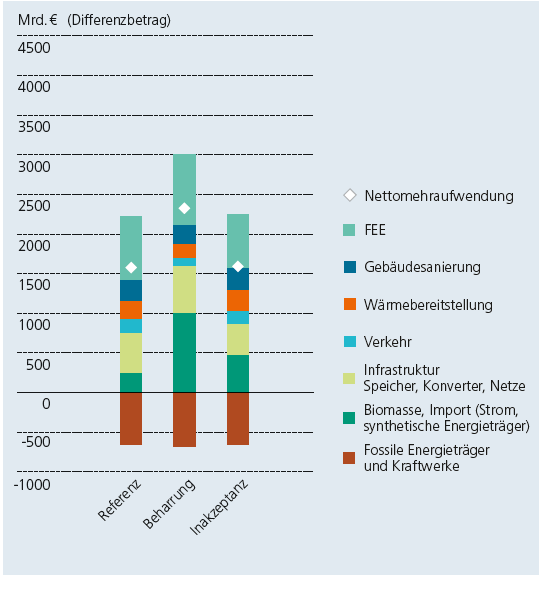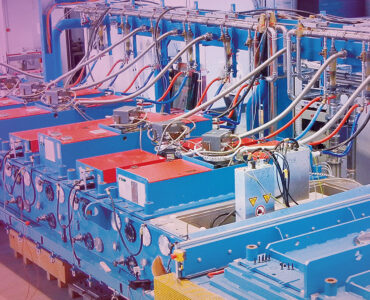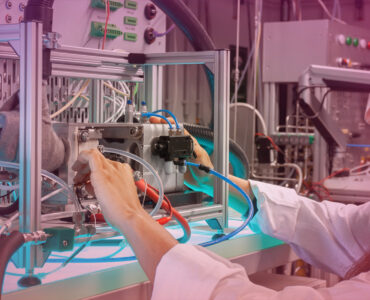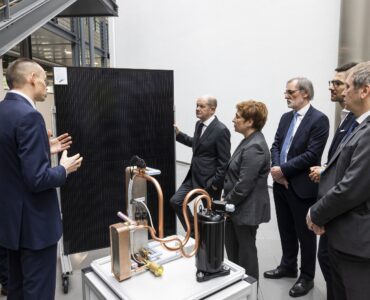To completely restructure an energy system, we as private individuals also have a role to play. That’s why we examined in one of the study’s scenarios the consequences of society’s unwillingness to switch to new electrical technologies.
What needs to happen by 2050 to reduce our CO2 emissions from transport, electricity, process and building heating by at least 95%? The study “Ways to a climate-neutral energy system” by our institute provides an encouraging answer to this question: In principle, it is technically feasible to secure the energy supply in Germany with renewable energies. How expensive and laborious this will be depends on each individual. In order to better understand how exactly this can be achieved, we have simulated the consequences of our behavior on the course of the energy transformation in various scenarios.
To completely restructure an energy system does not happen quietly in the background, it is a large-scale, joint effort. Many things, such as the construction of power transmission networks and wind turbines, are determined by the economy and politics. But for the paradigm shift to succeed, we as private individuals also have a role to play. That’s why we examined in one of the study’s scenarios the consequences of society’s unwillingness to switch to new electrical technologies. Specifically, we assumed for our calculations in this Persistence scenario that:
- Petrol and diesel vehicles will continue to account for at least half of annual new registrations in the future.
- Owners of electric cars are not willing to have their car batteries flexibly controlled to balance the current load on the grid.
- In the case of heating systems, gas boilers will continue to account for at least half of the new annual installations, while electric heat pumps will account for a maximum of 20 percent.
- The rate of energy-related refurbishment of buildings is only 1% per year.
Persistence scenario: What happens if we insist on using conventional technologies?
1. Synthetic fuels must replace fossil fuels
If we are not prepared to invest in new electrical technologies – such as electric cars and heat pumps – old technologies (such as gas boilers and combustion engines) will have to be powered by CO2 neutral fuels. So instead of petrol, diesel, natural gas, mineral oil and coal, we need green, liquid energy carriers and hydrogen in very large quantities. The simulation in our study calculates a demand of 890 TWh for the year 2050 in the Persistence scenario – almost four times as much as in the Sufficiency scenario (which assumes that we are trying to save energy).
2. Increased synthetic fuels mean more electricity generation and imports
In order to have sufficient synthetic fuels, two things need to happen: we need to install more renewable energy sources to produce the additional electricity we need to produce these fuels. Anything that we cannot produce locally would have to be imported. But that would only make sense if the countries producing them already have a surplus of renewably generated electricity. According to the calculations in our study, we would need over 500 TWh of imports of hydrogen and other liquid energy sources annually from 2050, in addition to the fuels we produce ourselves. This would be more than three times what Germany would have to import in the future if the energy transformation process were to be accomplished more optimally, i.e. more strongly based on electric consumers such as electric cars or heat pumps.
3. The required growth of renewable energy and imports is expensive
If we want to achieve a 95 percent reduction in CO2 emissions for the German energy system compared to 1990 and follow the cost-optimized path (Reference Scenario), the net additional expenditure would amount to around 1580 billion euros. For the Persistence scenario, on the other hand, the figure is 2330 billion euros. The graph also shows that acceptance of large infrastructures would only make the energy system transformation slightly more expensive in comparison. We would save a great deal of money and resources if we as a society endeavor to reduce our energy consumption (Sufficiency scenario).

This scenario illustrates very clearly that it all depends on us. Our private purchasing and investment decisions in new electrical technologies will also ultimately shape the energy turnaround. It was interesting for our research team to see that the import of synthetic, green fuels will become much more difficult and expensive. At the same time, the topic of the energy transformation is shifting to other countries where corresponding renewable energy capacities (approx. 200-300 GW of PV and wind power plants for 500 TWh of hydrogen) would have to be installed “for Germany”.
| What do you think which path Germany’s energy transition will take? Let us know and take part in our survey on the study. |









Add comment